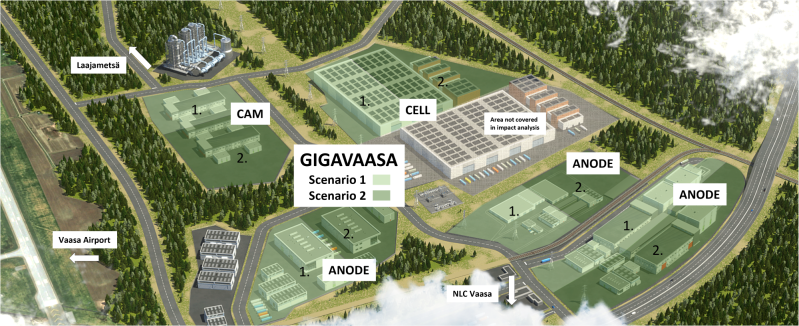GigaVaasa’s planned investments in the battery factory area will impact the entire country
The impact model assessed the direct and indirect effects of the battery cluster investments planned for the GigaVaasa area in Vaasa and Mustasaari on employment, output, added value, and tax revenues, as well as the regional distribution of the effects in the Vaasa region and the whole country.
 The assessment examined the investment and production phases and developed two different scenarios. Scenario 1 = situation in which the 1st stages of the investments are realised. Scenario 2 = situation in which the 2nd stages of the investments are realised. Approximately half of the area of the cell factory was excluded from the study. (Click the picture in order to download it in the bigger format).
The assessment examined the investment and production phases and developed two different scenarios. Scenario 1 = situation in which the 1st stages of the investments are realised. Scenario 2 = situation in which the 2nd stages of the investments are realised. Approximately half of the area of the cell factory was excluded from the study. (Click the picture in order to download it in the bigger format).
Recent impact model shows significant direct and indirect effects
The impact model assessed the direct and indirect effects of the battery cluster investments planned for the GigaVaasa area in Vaasa and Mustasaari on employment, output, added value, and tax revenues, as well as the regional distribution of the effects in the Vaasa region and the whole country.
The assessment examined the investment and production phases and developed two different scenarios. Scenario 1 = situation in which the 1st stages of the investments are realised. Scenario 2 = situation in which the 2nd stages of the investments are realised. Approximately half of the area of the cell factory was excluded from the study.
According to the results of the model, depending on the scenario used, the impacts of the production phase would be as follows
- 3 or 2.7 billion of added value, of which 0.8 or 1.7 billion would be allocated to the Vaasa region
- 5 200 or 10 400 new jobs, of which 2 400 or 4 900 in the Vaasa region
- 7 or 7.8 billion euros in generated output, of which 2.6 or 5.4 billion euros in the Vaasa region
- 111 or 224 million euros of wages would be passed on for consumption
- Find out more about the impact model (only in Finnish)
The work was carried out by Valtteri Laasonen and Rasmus Aro from MDI Public, a regional development consultancy, in collaboration with Seppo Laakso from Kaupunkitutkimus TA.
Significant impact on total output and added valuet
As a direct effect of the investments in the battery industry, a significant number of new jobs are created in the Vaasa region. The economic impact of these large investments on the region and its municipalities will be significant. The indirect effects will have wider implications for the entire country and for national growth.
The modelling shows that, depending on the scenario, the realisation of the investments will create more than 4 000 or more than 8 000 jobs in the construction phase, especially in the construction sector. The impact in the planning and indirectly in the manufacturing sector is also substantial. In the production phase, at the peak of activity, the overall impact is more than 5 000 to more than 10 000 jobs, particularly in the industrial sector. Jobs will also be created in, for example, logistics, warehousing, and processing of various materials.
The impact of GigaVaasa investments on total output and added value during production is very significant in both scenarios. Depending on the scenario, the annual impact is estimated to be between 2.5 and 3.7 billion euros for total output and between 0.8 and 1.3 billion euros for value added. However, most (76%) of the indirect impacts in the value chain will be generated elsewhere in Finland. Similarly, 2/3 of the multiplier effects of consumption are generated elsewhere in Finland.
The tax revenue effects are also significant. From the perspective of the Vaasa region, the most significant tax revenue effects arise from municipal taxes and corporation tax revenues. Annual land rents and property taxes also generate significant revenue for the municipalities. From the point of view of the state, VAT and corporation tax revenues are very significant, depending on the chosen implementation model. It is challenging to estimate their scale at this stage.
The impact model verifies the profitability of building the battery value chain
– Using this impact model, we understand both locally and nationally the potential of building a battery value chain. As the work has progressed, it has become clear that the overall picture is bigger than we expected, the numbers more significant than we have been able to see by focusing on our client work, says Tomas Häyry, Mayor of Vaasa, who leads the GigaVaasa team. He continues:
– The impact model also shows that making this new industry possible is profitable, and we have every reason to expect that society at large will join us in building this Finnish battery value chain. The battery sector is putting us on a path of positive growth, not only locally but also nationally and internationally, to which the EU also attaches importance.
– Two different scenarios were modelled, because the world is not the same in different situations. There can be different needs during the construction phase, for example, temporary peaks in labour. This impact model provides a glimpse into what will happen at different stages of the battery value chain, says Lead Specialist Valtteri Laasonen from MDI Public.
Finally, Häyry points out that the impact model is also important from the point of view of customers, that is, those considering and planning to invest in the area:
– This model gives our customers a picture of what will happen in the region more broadly, what synergies and scalability opportunities and new business opportunities are in store for both customers and subcontractors. The latest growth figures from EnergyVaasa’s autumn show that sustainable solutions have been made in the region. An example of this is the recently launched national employer image campaign, which addresses both current and future workforce needs, he says.

